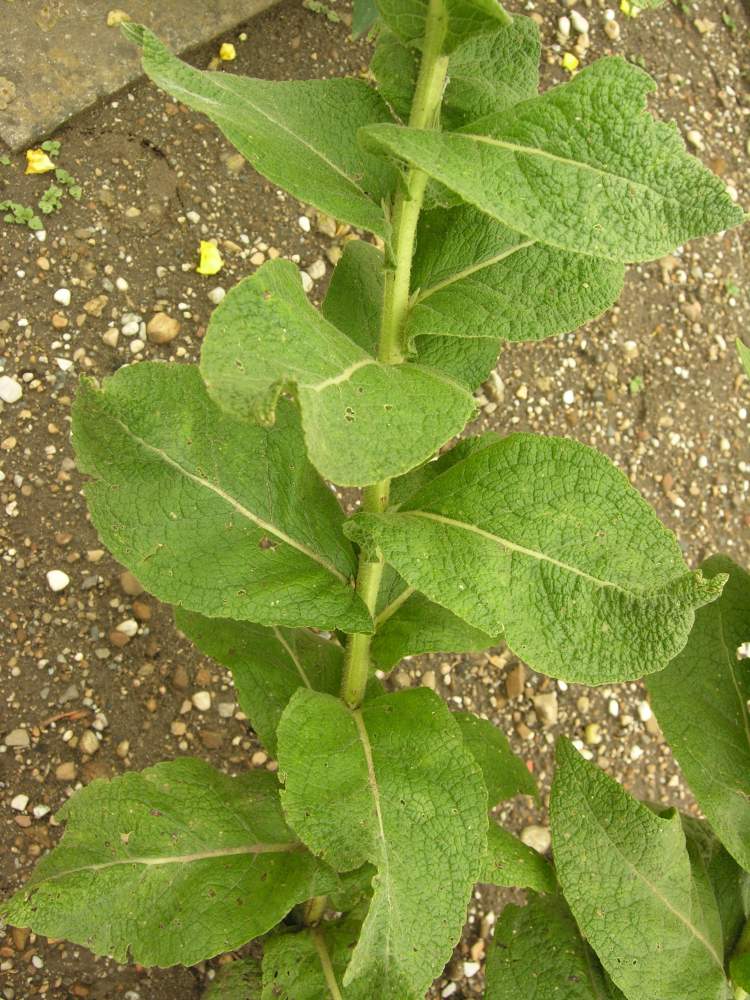Kerner's Mullein
(Verbascum kerneri)

Description
Verbascum kerneri, commonly known as Kerner's Mullein, is a captivating perennial herb that belongs to the family Scrophulariaceae. This plant species is native to the Balkan Peninsula, where it thrives in rocky and mountainous habitats. Named after Austrian botanist and physician Julius von Kerner, V. kerneri has gained popularity among gardeners for its attractive appearance, medicinal properties, and ability to attract beneficial insects. Description Verbascum kerneri is a herbaceous perennial that can grow up to 1.5 meters in height. It features a basal rosette of large, grey-green leaves that are covered in fine hairs, giving them a velvety texture. The leaves are lance-shaped with toothed margins and can reach lengths of 20-30 centimeters. From the center of the rosette emerges a tall, erect flowering stem, adorned with numerous yellow blossoms. Flowers The flowers of Verbascum kerneri are a true spectacle, forming dense spikes that can reach up to 60 centimeters in length. Each spike is composed of numerous individual flowers arranged in a beautiful symmetrical pattern. The five-petaled blossoms are a vibrant yellow color, with delicate reddish-brown markings at their base. These markings act as guides for pollinating insects, directing them towards the nectar-rich center of the flower. Habitat and Cultivation Verbascum kerneri is native to the Balkan Peninsula, where it thrives in rocky and mountainous habitats. It is particularly well-adapted to dry, well-drained soils and is commonly found in meadows, open woodlands, and slopes. In cultivation, V. kerneri is relatively low-maintenance and can be grown successfully in a variety of garden settings. It prefers full sun but can tolerate partial shade. The plant is hardy and can withstand cold temperatures, making it suitable for temperate climates. Medicinal Uses Throughout history, various parts of Verbascum kerneri have been used in traditional medicine for their therapeutic properties. The leaves and flowers of the plant contain mucilage, saponins, and flavonoids, which are believed to possess anti-inflammatory and expectorant properties. Infusions or decoctions made from V. kerneri have been used to alleviate respiratory ailments, such as coughs, bronchitis, and asthma. However, it is important to consult with a healthcare professional before using any herbal remedies. Ecological Importance V. kerneri plays a crucial role in supporting biodiversity and ecosystem health. The vibrant yellow flowers act as beacons, attracting a wide range of pollinators, including bees, butterflies, and hoverflies. These insects aid in the plant's reproduction by transferring pollen between flowers, ensuring the production of viable seeds. Additionally, V. kerneri serves as a host plant for the caterpillars of several butterfly species, contributing to the lifecycle and survival of these beautiful insects. Gardening Tips If you are considering introducing Verbascum kerneri to your garden, here are some helpful tips for successful cultivation: Soil and Drainage: Provide well-drained soil with a neutral to slightly alkaline pH. Amend heavy clay soils with organic matter to improve drainage. Sun Exposure: V. kerneri thrives in full sun and prefers at least 6 hours of direct sunlight per day. Choose a location in your garden that receives ample sunlight to promote healthy growth and vibrant flower production. Watering: While Verbascum kerneri is relatively drought-tolerant once established, it is important to provide regular watering during the plant's early growth stages. Water deeply, allowing the soil to dry slightly between waterings to prevent waterlogged conditions. Mulching: Apply a layer of organic mulch around the base of the plant to help conserve moisture, suppress weed growth, and regulate soil temperature. Mulching also adds nutrients to the soil as it breaks down over time. Pruning: Deadhead spent flowers regularly to promote continuous blooming and prevent self-seeding. Cut back the flowering stems to the base of the plant after the blooming season to maintain a tidy appearance and encourage new growth in the following year. Propagation: Verbascum kerneri can be propagated through seeds or root cuttings. Collect seeds from mature plants and sow them in early spring or fall. Root cuttings can be taken in late autumn or early spring. Ensure the cuttings are placed in well-draining soil and kept slightly moist until they establish roots. Pest and Disease Management: V. kerneri is generally resistant to common pests and diseases. However, keep an eye out for aphids or powdery mildew. Regularly inspect the plant and take appropriate measures, such as using organic insecticides or fungicides, if necessary. Wildlife Attraction: V. kerneri's vibrant flowers attract beneficial insects to your garden. To encourage more pollinators, avoid using chemical pesticides that may harm them. Creating a pollinator-friendly garden with diverse flowering plants can enhance the overall ecosystem in your yard. Conclusion Verbascum kerneri, with its striking yellow flowers and unique velvety leaves, is an excellent addition to any garden. This perennial herb not only provides visual appeal but also offers medicinal benefits and supports local ecosystems by attracting pollinators. With proper care and cultivation, you can enjoy the beauty and benefits of V. kerneri in your garden for years to come.
Taxonomic tree:







